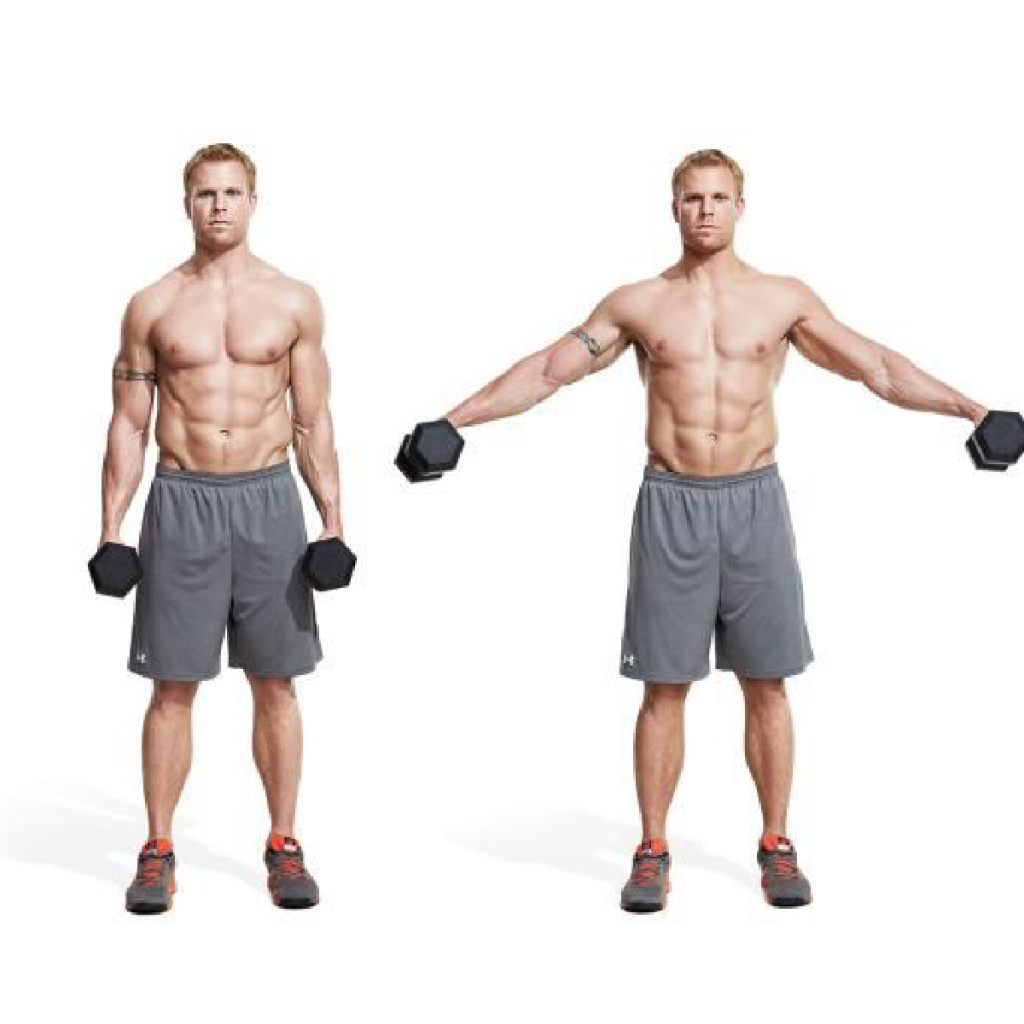Learn how to build shoulder muscles effectively with this step-by-step guide.
How to Build Shoulder Muscles: A Step-by-Step Guide
Looking to build some impressive shoulder muscles? You’ve come to the right place! In this step-by-step guide, we’ll explore everything you need to know about building strong and well-defined shoulders. From understanding the anatomy of the shoulder to learning advanced techniques and focusing on nutrition, we’ve got you covered. So, let’s dive in and get those delts popping!

Understanding Shoulder Muscles
Before we start pumping iron, it’s important to have a basic understanding of the muscles we’ll be targeting. The shoulder is a complex joint made up of several muscles, including the deltoids, which consist of the anterior (front), medial (middle), and posterior (rear) heads. Each plays a unique role in various shoulder movements.
The anterior deltoids, located at the front of the shoulder, are responsible for movements such as shoulder flexion (lifting your arm forward). These muscles are heavily involved in activities like reaching for objects, throwing a ball, or performing a chest press exercise. Strengthening the anterior deltoids can improve your ability to perform these movements with ease and power.
The medial deltoids, situated in the middle of the shoulder, come into play during shoulder abduction (lifting your arm to the side). These muscles are essential for movements like lateral raises, which target the sides of the shoulders. Strengthening the medial deltoids can improve your shoulder width and create a more balanced upper body appearance.
The posterior deltoids, located at the rear of the shoulder, get activated when you perform shoulder extension (moving your arm backward). These muscles are involved in pulling movements, such as rows or pull-ups, as well as exercises that target the rear delts specifically. Strengthening the posterior deltoids can improve your posture, as they help counterbalance the effects of rounded shoulders and strengthen the muscles that support the upper back.
Anatomy of the Shoulder
The shoulder joint is a remarkable structure that allows for a wide range of motion. It consists of the humerus (upper arm bone), scapula (shoulder blade), and clavicle (collarbone). The head of the humerus fits into a shallow socket on the scapula called the glenoid fossa, forming a ball-and-socket joint. This design provides flexibility but also makes the shoulder susceptible to instability and injury.
Surrounding the shoulder joint are several important structures, including tendons, ligaments, and muscles. Tendons are tough bands of connective tissue that attach muscles to bones, allowing for movement. Ligaments, on the other hand, connect bones to other bones, providing stability to the joint. The muscles surrounding the shoulder joint work together to produce the various movements we perform on a daily basis.
Importance of Strong Shoulder Muscles
Building strong shoulder muscles is not just about looking good in a tank top. Having well-developed delts is crucial for overall upper body strength and stability. Strong shoulders not only enhance your performance in other exercises but also help prevent injuries by providing support and stability to the surrounding joints, such as the neck and upper back.
When you have strong shoulder muscles, you can perform pushing and pulling movements with more power and control. This translates to improved performance in exercises like bench presses, overhead presses, and pull-ups. Additionally, strong shoulders contribute to better posture, as they help maintain proper alignment of the spine and reduce the risk of developing rounded shoulders or a hunched back.
Furthermore, strong shoulder muscles play a vital role in everyday activities. Whether you’re carrying groceries, lifting a child, or reaching for something on a high shelf, having well-developed delts can make these tasks easier and less prone to injury. By strengthening your shoulder muscles, you can enhance your overall functional fitness and improve your quality of life.
Preparing for Shoulder Muscle Building
Now that we know why shoulder muscle building matters, let’s cover some key aspects you need to consider before hitting the weights.
Building strong and well-defined shoulder muscles not only enhances your overall physique but also plays a crucial role in improving your upper body strength and stability. Whether you’re an athlete looking to enhance your performance or simply someone who wants to have a well-rounded physique, focusing on shoulder muscle building is a great way to achieve your goals.
Safety Measures and Precautions
Prioritizing safety is of utmost importance when it comes to any type of exercise. Before engaging in shoulder workouts, make sure you warm up properly to increase blood flow to the muscles and reduce the risk of injury. A dynamic warm-up routine that includes arm circles, shoulder rolls, and shoulder stretches can help prepare your shoulders for the upcoming workout.
In addition to warming up, it’s essential to pay close attention to your form and technique throughout each exercise to avoid unnecessary strain on your shoulders. Proper form not only maximizes the effectiveness of the exercise but also minimizes the risk of injury. If you’re unsure about the correct form, consider seeking guidance from a qualified fitness professional or watching instructional videos from reputable sources.
Furthermore, it’s important to listen to your body and avoid pushing through pain or discomfort. If you experience any sharp or persistent pain during your shoulder workouts, it’s crucial to stop and seek medical advice to prevent further injury.
Necessary Equipment for Shoulder Workouts
While you don’t need fancy equipment to work your shoulders, having a few essentials can greatly enhance your workouts. A pair of dumbbells is a versatile tool that allows you to perform a wide range of shoulder exercises, such as dumbbell shoulder presses, lateral raises, and front raises. Opt for dumbbells that are appropriate for your strength level and gradually increase the weight as you progress.
In addition to dumbbells, a barbell can be a valuable addition to your shoulder workout routine. Barbell exercises like overhead presses and upright rows target multiple shoulder muscles simultaneously, providing a challenging and effective workout. Make sure to start with lighter weights and gradually increase the load as your strength improves.
A resistance band is another useful piece of equipment that can add variety to your shoulder workouts. It allows you to perform exercises like band pull-aparts and external rotations, which target different angles and muscle fibers in your shoulders. Resistance bands are also lightweight and portable, making them a convenient option for home workouts or when you’re on the go.
As you progress in your shoulder muscle building journey, you can also explore using kettlebells and cable machines for some variety. Kettlebell exercises like kettlebell swings and Turkish get-ups engage your shoulder muscles in unique ways, challenging your stability and coordination. Cable machines, on the other hand, provide constant tension throughout the range of motion, allowing for greater muscle activation and development.
Remember, the key to effective shoulder muscle building is consistency and progressive overload. Gradually increase the intensity, volume, or resistance of your workouts over time to continually challenge your muscles and stimulate growth. And always prioritize proper form and safety to ensure long-term success and injury prevention.
Basic Exercises for Shoulder Muscle Building
Ready to start sculpting those shoulders? Here are some foundational exercises that target the different heads of the deltoids:
Dumbbell Shoulder Press
This classic move is a staple for building shoulder strength. Start by sitting on a bench with a dumbbell in each hand at shoulder level. Press the weights overhead while keeping your core engaged and your back straight. Lower the dumbbells back to shoulder level and repeat for multiple sets and repetitions.
The dumbbell shoulder press primarily targets the anterior head of the deltoids, but it also engages the triceps and upper chest muscles. This compound exercise not only helps in building shoulder strength but also improves overall upper body stability.
When performing the dumbbell shoulder press, it is important to maintain proper form. Keep your elbows slightly in front of your body and avoid arching your back. Engage your core muscles to stabilize your body throughout the movement. Gradually increase the weight as you progress to challenge your muscles and promote growth.
Lateral Raises
For those sought-after round deltoids, lateral raises are your go-to exercise. Stand with dumbbells in each hand, palms facing your body. Raise the weights out to your sides until they’re at shoulder height. Slowly lower them back down and repeat. Remember to engage your core and maintain proper form throughout the movement.
Lateral raises primarily target the lateral head of the deltoids, which helps in achieving that desirable rounded shoulder appearance. This exercise also engages the trapezius and rotator cuff muscles, contributing to overall shoulder stability.
When performing lateral raises, it is crucial to avoid using momentum to lift the weights. Focus on a controlled movement, keeping your elbows slightly bent and your wrists neutral. Engage your core muscles to maintain stability and prevent excessive swinging of the body. Gradually increase the weight as you progress to challenge your muscles and stimulate growth.
Adding variation to your shoulder workout routine is essential for balanced muscle development. Incorporate exercises such as front raises, bent-over lateral raises, and upright rows to target different areas of the deltoids. Remember to always warm up before your workout and listen to your body to prevent injuries. With consistency and proper form, you’ll be on your way to sculpted and strong shoulders!
Advanced Shoulder Muscle Building Techniques
If you’re looking to take your shoulder development to the next level, here are a couple of advanced techniques that will really challenge your muscles:
Barbell Shrugs
While often associated with working the trapezius muscles, barbell shrugs also engage the upper part of the shoulders. Stand with a barbell in front of you, grip it with an overhand grip just wider than shoulder-width apart. Lift your shoulders up as high as you can, hold for a moment, and then lower them back down. Repeat for multiple sets and feel the burn!
Face Pulls
To target the posterior deltoids and strengthen the muscles of your upper back, face pulls are a fantastic exercise. Attach a rope handle to a cable machine at chest height. Stand with your feet shoulder-width apart, grasp the rope, and pull it towards your face, allowing your elbows to flare out to the sides. Squeeze your shoulder blades together and return to the starting position. Your shoulders will be singing after these!
Nutrition for Building Shoulder Muscles
Now that we’ve covered the exercise aspect, let’s shift our focus to nutrition, which plays a pivotal role in muscle building. Here are a few key considerations:

Importance of Protein in Muscle Building
Protein is the building block of muscles, so it goes without saying that it’s a vital component of your diet. Incorporate lean protein sources, such as chicken, fish, tofu, and legumes, into your meals. Aim to consume an adequate amount of protein with each meal to support muscle repair and growth.
Hydration and Muscle Development
Staying hydrated is often overlooked but is essential for optimal muscle function and development. Make sure to drink enough water throughout the day to prevent dehydration. Additionally, consider adding electrolytes to your water during intense workouts to replenish what is lost through sweat.
With these tips in mind, you’re well on your way to building impressive shoulder muscles. Remember to pace yourself, listen to your body, and enjoy the process. Get ready to rock those sleeveless shirts with confidence!







